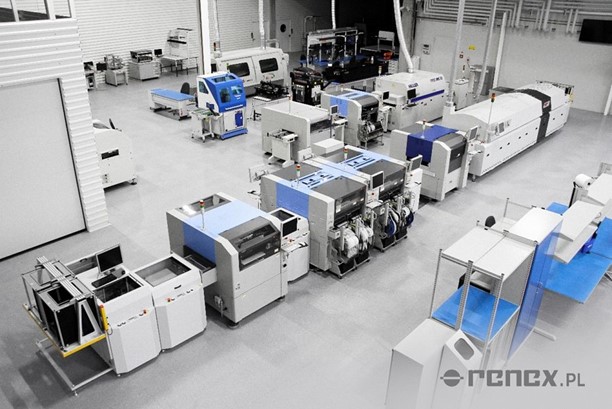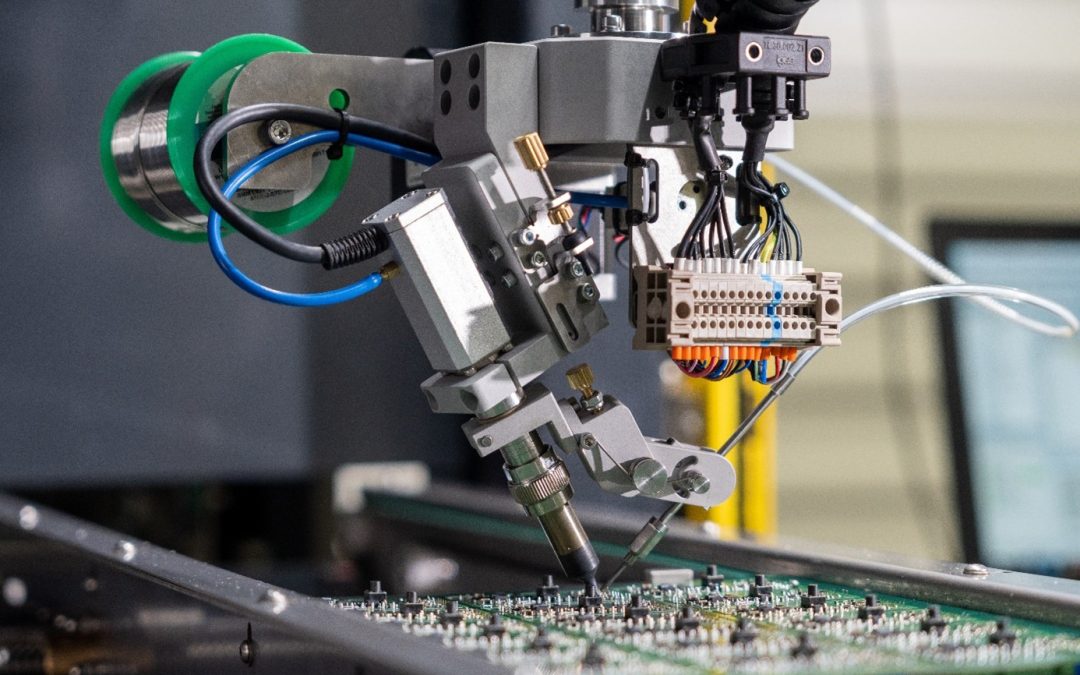Modern EMS manufacturing companies are increasingly using automation for tasks that previously required manual labor. In recent years, there has been a noticeable shift in the development processes of companies, where previous automation of electronics production lines has been largely supplemented.
Automation of production processes in the electronics industry – key to competitive advantage
Currently, companies thriving in the electronics market practically cannot afford to lack a comprehensive SMT line. In an era of increasing competition, automation has become crucial in improving the efficiency of electronic device production processes. There is significant interest in automating processes such as THT soldering, conformal coating application, and assembling and gluing housings, which were previously considered “additional” and performed manually. This is all to gain an advantage over the competition.

Currently, companies thriving in the electronics market practically cannot afford to lack a comprehensive SMT line. In an era of increasing competition, automation has become crucial in improving the efficiency of electronic device production processes. There is significant interest in automating processes such as THT soldering, conformal coating application, and assembling and gluing housings, which were previously considered “additional” and performed manually. This is all to gain an advantage over the competition.
REECO Soldering Robot – Innovative Solution for Automating the Soldering Process in Small and Medium Batches
To meet the needs of automating the soldering process in small and medium batches of products, the REECO Soldering Robot was developed. It consists of a precise, 4-axis SCARA-type manipulator from YAMAHA, housed in a specially designed safety cage. The end of the robot arm features a soldering head with a tip and a solder feeder. This allows for the creation of accurate soldered connections according to a specified pattern. A PLC controller manages all auxiliary devices, such as transport, soldering generator, wire feeder, and tip cleaning stations, making the process easy and quick to program
To meet the needs of automating the soldering process in small and medium batches of products, the REECO Soldering Robot was developed. It consists of a precise, 4-axis SCARA-type manipulator from YAMAHA, housed in a specially designed safety cage. The end of the robot arm features a soldering head with a tip and a solder feeder. This allows for the creation of accurate soldered connections according to a specified pattern. A PLC controller manages all auxiliary devices, such as transport, soldering generator, wire feeder, and tip cleaning stations, making the process easy and quick to program
The REECO Soldering Robot stands out among other similar devices due to its low power consumption. Compared to traditional soldering waves, this solution does not require the use of expensive carriers. Moreover, the device allows for soldering components that are not resistant to high temperatures, such as external antennas, which are factory-embedded in plastic. These features enable the robot to efficiently perform fine soldering that was previously impossible to automate.



Automation of applying and distributing semi-liquid substances on the production line in the electronics industry: benefits
Another task on the production line that often requires manual execution is applying or distributing various types of semi-liquid substances. In the electronics industry, gaskets, adhesives, but also paints or lubricants are commonly used. Automating these processes can bring many benefits, including increased speed and accuracy of application, reduced material consumption, and minimized risk of errors and defective products.
As previously mentioned in the context of soldering, the human hand is sometimes precise enough compared to a robot. However, in the case of dispensing, automation is essential. It is impossible for a person to distribute a gasket or apply adhesive as accurately as a robot. A human will never be able to perfectly match the amount of material dispensed to ensure an even path, especially in difficult areas such as corners or curves of the pattern. This is why automating “other” tasks in the electronics production line is not only beneficial but also necessary to achieve the highest product quality.
Impact of automation on surface coating quality in electronics production
Should we consider automating supplementary processes in the electronics production line? This question is justified, given how shortcomings in the amount of applied material can affect product quality. Warranty claims related to device leakage are a financial and reputational loss for companies. On the other hand, excess material can lead to even more serious problems, such as blocking moving parts of the device or insulating elements that should remain exposed. A thick gasket layer in one place can cause leakage in another. These issues can lead to increased material consumption, as well as the time and resources needed to clean the product from adhesive that has leaked outside the housing.
Surface coating processes are an integral part of the electronics industry, especially when it comes to applying conformal coatings. These types of protections are becoming increasingly common due to the growing use of electronics in outdoor devices, such as gate control elements, garden sprinklers, or motorcycle components. Technological development indicates that this trend will intensify.
In the electronics production industry, automating processes becomes increasingly important, particularly for tasks such as dispensing and applying coatings. Manually performing these activities can lead to inaccurate surface coverage, which can negatively affect product quality. Insufficient coating thickness or incomplete coverage can result in a lack of proper protection for the electronics, while a too thick layer means material wastage. Therefore, more and more companies are opting for automating these processes, which yields positive results and minimizes human errors.

REECO dispensing and coating robots – flexible solutions for applying substances of various densities and evenly applying coatings
To address production issues related to applying substances of varying densities and evenly applying liquid coatings, REECO Dispensing and Coating Robots can be utilized. These robots are easy to operate and ready to use without complicated implementation, similar to the previously described Soldering Robot. The Dispensing Robot is designed to enable precise and automatic application of substances of different densities, such as adhesives, gaskets, paints, lubricants, and other similar consistency materials, along a predetermined path. The Coating Robot is equipped with a spray valve that allows for even application of liquid coatings of various viscosities.
.
Additionally, the innovative integrated nozzle cleaning system eliminates the need for manual valve cleaning, allowing for efficient and precise coating application. In both cases, the object to be coated – e.g., a housing – is introduced into the work area using edge transport or a rotary table. The robot, equipped with a suitably selected head nozzle, distributes the substance according to the previously programmed path and in precisely measured amounts. This makes the process much faster, minimizes material usage, and produces products with the highest possible precision.
Automating the assembly of housing and electronics components using the reeco screwing robot
One of the tasks beyond the standard SMT line in companies involved in electronics production is assembling housing and electronics components. This process, whose repeatability and tediousness are challenging for workers, is often performed manually or semi-automatically. However, due to the small size of the screws and bolts used, workers need high precision, which affects work efficiency. Therefore, more and more companies are introducing automation of these tasks to increase efficiency and improve the quality of the final product.
The solution to this problem is the automation of the process, as discussed in this study. The REECO Screwing Robot allows for replacing human labor in production stages where assembly is required. As with the previously discussed models, the element being worked on is introduced into the work area using edge transport or a rotary table. The robot, following the program, picks up the appropriate screws from the feeder and screws them into the holes with a predetermined torque, ensuring complete repeatability and precision while minimizing the risk of human errors.
It is worth noting that all devices from the REECO Robot series, except for YAMAHA components, are based on the REECO robotic system. Thanks to this, the head in these devices can be easily changed. For example, the painting robot can be easily converted to a soldering, screwing, dispensing, or other robot – depending on production needs or changing market conditions. Such flexibility allows users to quickly reorganize the production line without having to purchase a new device.
RENEX Group and Its REECO Robots – comprehensive advisory, training, and service solutions for the electronics industry
Automating various stages and tasks in the production process of electronic devices, including soldering THT components, applying coatings, dispensing, and assembly, is becoming increasingly important to maintain a competitive advantage in the market. Many manufacturers are compelled to take action in this direction. One solution that can help address this issue is ready-to-implement REECO robots. The RENEX Technology and Training Center, with a team of qualified specialists, can assist companies in implementing, training, and servicing such robots
RENEX Group, one of the largest companies with over 30 years of experience in the electronics industry, has developed the REECO series of robots. This company not only provides the devices themselves but also comprehensive advisory, service, and training services. As part of these services, specialists from the RENEX Technology and Training Center help identify production problems and select appropriate technological solutions. The center also offers training on robotic solutions, including training that enables users to fully utilize the capabilities of industrial robots.
The RENEX Technology and Training Center helps tailor processes in companies operating in the market, especially for companies developing or implementing their own production of electronics and devices, and implementing process automation. The center also advises on protection against electrostatic discharge (ESD) and the creation and maintenance of ESD protective zones (EPA).


RENEX is a company that offers comprehensive solutions, including various service options, both warranty and post-warranty. These services include advice on proper equipment use and preventive maintenance, minimizing the risk of failures and related downtimes. It is worth noting that the RENEX Group Service Department was recognized by YAMAHA as the Best Production Equipment Service in Europe in 2020, confirming the highest global standard of the services provided.
For inquiries, please contact dth@renex.pl
More information at www.renex.pl
